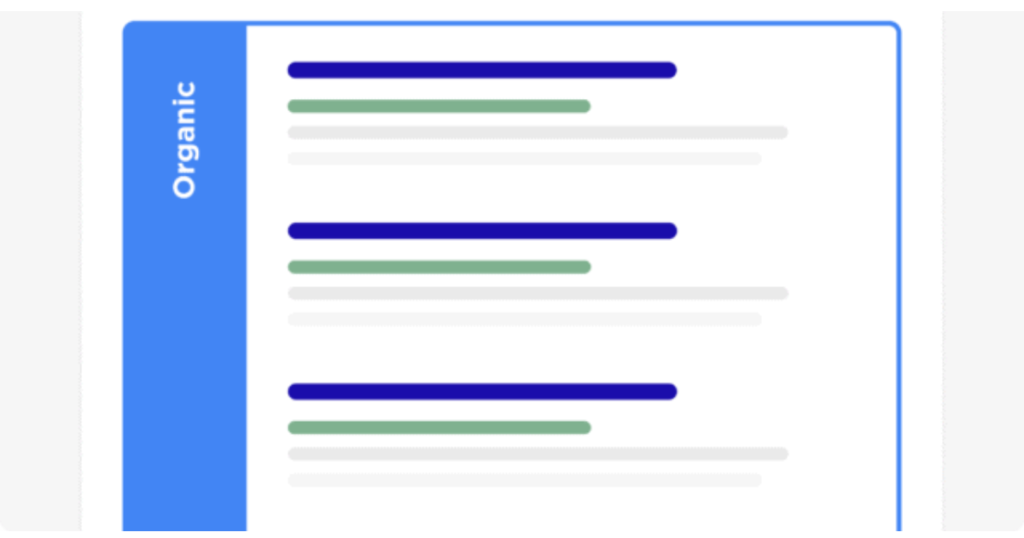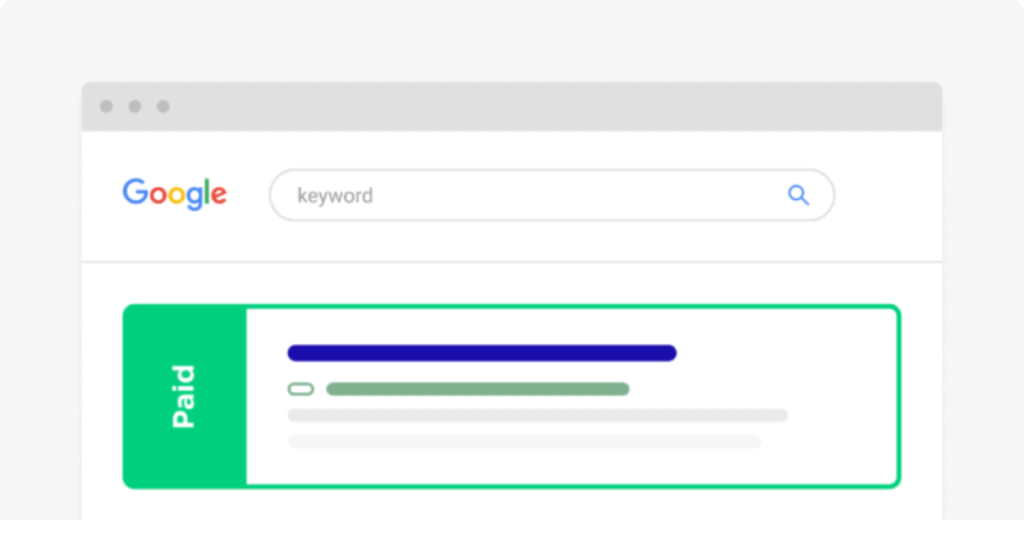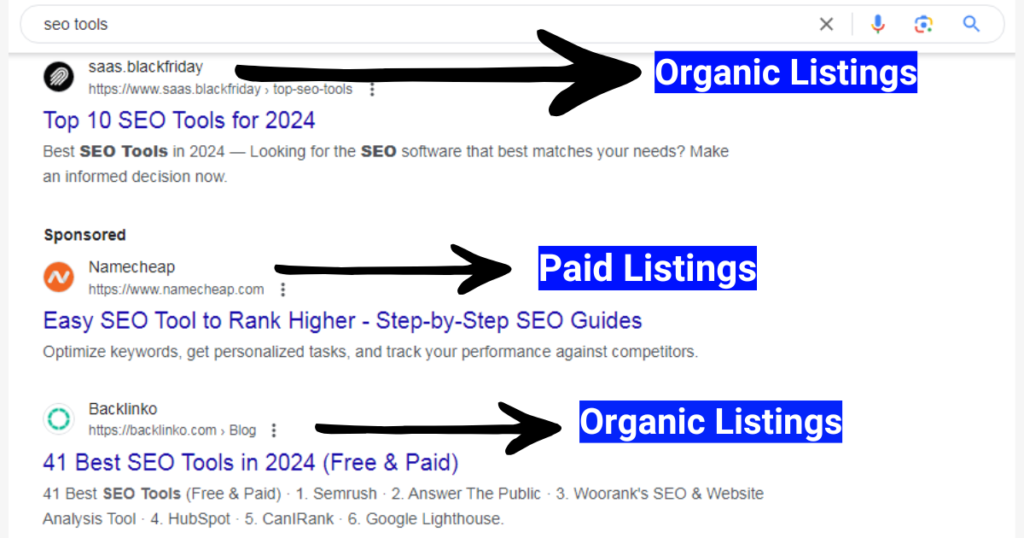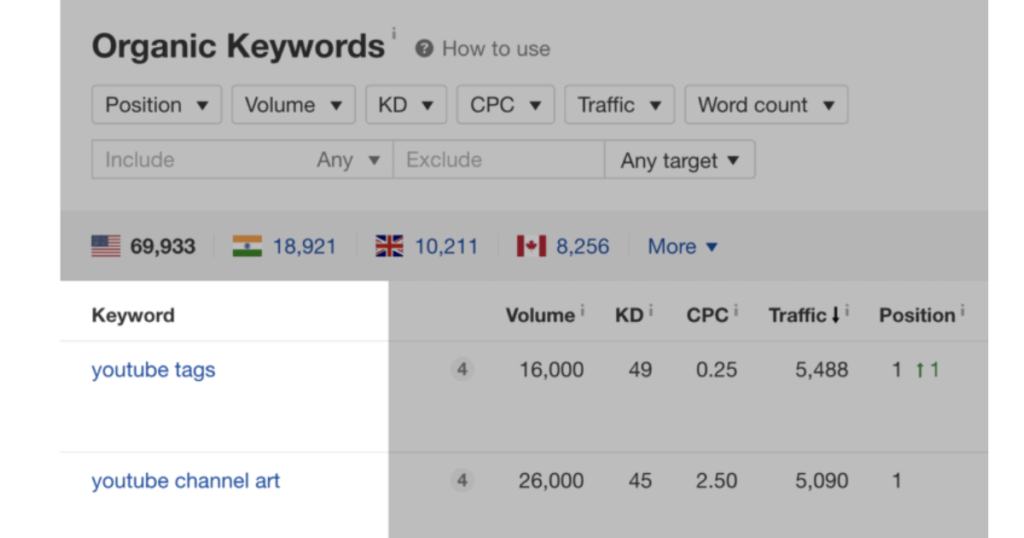Search Engine Optimization (SEO) aims to improve a website’s organic search engine rankings, while Search Engine Marketing (SEM) encompasses both organic and paid search strategies to increase website traffic and visibility.
Essentially, Google search results are divided into two categories: organic and paid. SEO focuses on optimizing a website to appear higher in organic results, while SEM includes paid advertising to appear in the top, sponsored positions.
Table of Contents


The goal of SEO is to rank your website in the organic search results.

You can also increase your website’s visibility by using pay-per-click (PPC) advertising to appear in the sponsored search results.

SEO focuses solely on improving organic search rankings, while SEM utilizes both organic and paid search strategies to increase website traffic.


SEM is a broader term that encompasses both SEO and PPC.
Think of SEM as an umbrella term, with SEO and PPC being two key strategies under it. While SEO focuses on organic search results, PPC involves paid advertising to appear at the top of search engine results pages.

Now that we’ve clarified the relationship between SEO and SEM, let’s delve into their key differences.
SEO vs SEM: Main Features
SEO Overview
SEO is the practice of optimizing a website to improve its organic search engine rankings. Google’s complex algorithm considers over 200 factors, but SEO can be broadly categorized into four key areas:
On-Page SEO: On-page SEO involves optimizing individual web pages to improve their search engine rankings. This includes incorporating relevant keywords into your content, title tags, meta descriptions, and URLs. For instance, using your target keyword in your page’s title and header tags can help search engines understand the topic of your page.

Off-Page SEO: This focuses on building high-quality backlinks from other reputable websites to increase your website’s authority and credibility. Additionally, factors like E-A-T (Expertise, Authoritativeness, Trustworthiness) and social media signals can also influence your website’s ranking.

Technical SEO: This involves optimizing your website’s technical aspects to ensure search engines can easily crawl, index, and understand your content. Technical SEO Key factors include website speed, mobile-friendliness, and proper Website architecture.

User Interaction Signals: Google analyzes user behavior on your website to determine its relevance and quality. Metrics like bounce rate and dwell time can impact your rankings. A high bounce rate, for instance, may indicate that your content doesn’t meet user expectations, which could lead to lower rankings.
SEM: A Comprehensive Approach to Online Visibility
As we’ve discussed, Search Engine Marketing (SEM) is a broad term encompassing both organic and paid search strategies. While SEO focuses on optimizing your website for organic search results, PPC leverages paid advertising to drive immediate traffic.
Pay-Per-Click (PPC) Advertising
PPC advertising, a core component of SEM, involves bidding on specific keywords. When a user searches for that keyword, your ad may appear at the top of the search results page. This allows you to quickly reach your target audience and generate immediate traffic.
Key aspects of PPC advertising include:
- Bidding: Determining the maximum amount you’re willing to pay for a click on your ad.
- Ad Copy: Crafting compelling ad copy to attract user attention and encourage clicks.
- Landing Pages: Creating high-quality landing pages that align with your ad copy and offer a seamless user experience.
- Keyword Targeting: Identifying relevant keywords to target your desired audience.
- Quality Score: A metric used by search engines to assess the quality and relevance of your ads and landing pages.
Typically, the higher you bid on a keyword, the higher your ad will rank on the search engine results page. However, it’s important to note that other factors, such as ad quality and relevance, also influence ad position.


When a user clicks on your ad, you’ll pay the amount you bid on that keyword. This is known as the Cost Per Click (CPC).
Quality Score
Quality Score is a crucial metric in Google Ads that measures the relevance and quality of your ads and landing pages. Google uses this score to determine your ad’s position and cost-per-click. A higher Quality Score can lead to lower CPCs and better ad positions.
Factors that influence Quality Score include:
- Click-Through Rate (CTR): The percentage of users who click on your ad after seeing it.
- Ad Relevance: How well your ad matches the user’s search query.
- Landing Page Experience: The quality and relevance of your landing page to the ad and keyword.

Ad Copy
Writing compelling ad copy is critical for PPC success. A well-crafted ad with a strong call-to-action can significantly improve your Click-Through Rate (CTR). A higher CTR, in turn, leads to a better Quality Score, resulting in lower costs per click. Conversely, poor-quality ad copy can negatively impact your Quality Score and increase your advertising costs.
Ad Groups and Account Management
Leveraging the data within your Google Ads account is essential for optimizing your ad spend. By analyzing performance metrics, you can identify opportunities to improve your campaign’s efficiency and effectiveness.
SEO vs. SEM: How Long It Takes to See Results
One major difference between SEO and SEM is the time it takes to see results.
SEO is a long-term strategy that can take months, or even years, to yield significant results. Especially for new websites with limited backlink profiles, it can take an average of two years to rank on the first page of Google. Many of the top-ranking pages today were first published several years ago.
While it can take several years to rank for highly competitive keywords, focusing on long-tail keywords and implementing SEO best practices can yield results within a few months.
For example, when Backlinko was launched in 2013, it had little domain authority. However, through dedicated effort and SEO optimization, the website was able to attract organic traffic within a relatively short period.

That said, it did take years for my rankings and organic traffic to really climb.

In contrast, PPC campaigns can deliver results almost instantly. You can launch an ad campaign in the morning and start seeing traffic and conversions that same afternoon. However, achieving a positive return on investment (ROI) often requires months of testing and optimization. While PPC offers faster results compared to SEO, it’s essential to implement effective strategies to ensure profitability.
SEO vs SEM: How Much They Cost
Many people are attracted to SEO because it offers “free” website traffic. While it’s true that you don’t pay for clicks from organic search results, SEO itself requires significant investment.
Let’s consider one of my pages that currently ranks #1 for “on-page SEO.”

Ranking #1 for a competitive keyword is a fantastic achievement. It generates consistent, organic traffic without any additional cost. However, achieving such a high ranking requires substantial investment in terms of time, effort, and resources.
To rank #1 for “on-page SEO,” I had to consistently create high-quality content and actively promote it through email outreach to build Backlinko’s domain authority.
To identify the target keyword, I utilized a paid SEO tool costing $355 per month. Creating the content itself required over 20 hours of work. Additionally, we invested in professional design services, hiring a graphic designer for screenshots and an illustrator for custom illustrations.



A developer was also involved in coding and deploying the page. There was no guarantee that this page would rank well.
In contrast, with a pure PPC approach, you invest upfront and immediately see results. You can even automate your bidding strategy to maintain a specific ad position.
In the short term, PPC can often be more cost-effective than SEO. However, the sustainability of PPC is questionable.
Once you stop paying, your traffic ceases.
SEO, on the other hand, offers long-term benefits. Once you achieve high rankings, you can enjoy consistent organic traffic without ongoing significant financial investment.
To maximize results, most businesses employ a combined SEO and PPC strategy.
SEO or PPC: What to Focus On
When to Focus Solely on SEO
Limited Budget: If you’re a startup or small business with a tight marketing budget, SEO might be the most prudent choice. While SEO can take time to yield results, it’s a more cost-effective long-term strategy than PPC, which requires continuous investment.
Informational Keywords: If you can create exceptional content around informational keywords like “What is X” or “How to X,” SEO can be highly effective. These keywords often attract significant search volume, and ranking for them can drive consistent organic traffic to your website.



You Can Wait: SEO and content marketing takes time to kick in. So if you can play the long game and wait 6-12 months to see legit traffic start to roll in from Google search, go with SEO.
You’re Good at Link Building: Creating high-quality content is a key part of ranking in Google. But it’s not enough. If you’re serious about ranking, you’ll need to also use a few different link-building strategies to get other sites to link to you.

When to Consider PPC Advertising
PPC (Pay-Per-Click) advertising can be a powerful tool to drive immediate traffic to your website. However, it’s not suitable for everyone. Here are some key considerations to determine if PPC is right for your business:
1. Consistent Ad Budget:
- Financial Capacity: Ensure you have a dedicated budget to allocate to PPC campaigns.
- Budget Management: Be prepared to manage your budget effectively to avoid overspending.
- Learning Curve: Understand that it takes time to optimize campaigns and achieve optimal results.
2. Ad Account Management Skills:
- Technical Proficiency: Familiarity with Google Ads or other PPC platforms is essential.
- Data Analysis: The ability to analyze campaign performance metrics and make data-driven decisions is crucial.
- Time Commitment: Managing PPC campaigns requires ongoing effort and attention.
3. Landing Page Optimization:
- Targeted Landing Pages: Create highly relevant landing pages tailored to specific ad groups and keywords.
- A/B Testing: Continuously test different landing page elements to improve conversion rates.
- Technical Expertise: Possess the skills to build and deploy landing pages quickly and efficiently.
If you meet these criteria, PPC advertising can be a valuable addition to your marketing strategy. However, if you’re unsure about your capabilities, consider hiring a PPC specialist or agency to handle your campaigns.
When to Combine SEO and PPC
While SEO and PPC are distinct strategies, there are instances where a combined approach can yield significant benefits.
Consider a simultaneous approach when:
- You have a dedicated team: A skilled team can effectively manage both SEO and PPC campaigns, ensuring optimal results.
- Your budget allows: A sufficient budget is necessary to allocate resources to both strategies.
- You have clear goals: A well-defined marketing objective will help you determine the best approach.
A Word of Caution:
Undertaking both SEO and PPC simultaneously can be resource-intensive. If you’re a small business owner or a solopreneur, it’s advisable to prioritize one strategy. Overextending yourself can lead to suboptimal performance in both areas.
By carefully assessing your resources and goals, you can determine the most effective SEM strategy for your business.
Learn More
What is SEO? How to Optimize Your Site for Google: A deep-dive into what search engine optimization is, what it involves, and how to get started with it.
The Definitive Guide to Keyword Research: A guide to finding keywords for SEO. But many of the strategies also apply to keyword research for Google Ad campaigns.
Google Adwords Tutorial with Step-by-Step Walkthrough: Super good tutorial on getting started with Google Ads.
